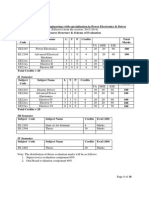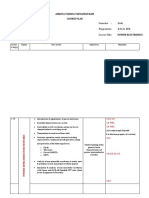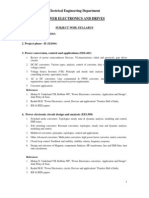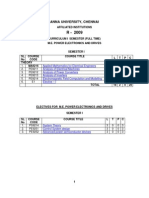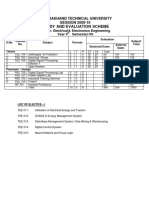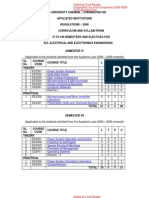Concordia University
Department of Electrical and Computer
Engineering
Power Electronics (I) ELEC-433/6411
Week 1
Review of basic concepts
(Chapter 3)
�ELEC 433
NO Final Exam.
Two Tests (20% and 30%)
17 October (20%) and 28 November (30%)
Mini Project (20%: Q&A + short report)
Short report (key design equations, voltage and current rating of
components, results, analytical values, analysis and discussion of results)
Due date: 05 December, online only (softcopy)
2 Assignments (5% each).
Labs (20%)
�ELEC 6411
NO Final Exam.
Two Tests (20% and 30%)
17 October (20%) and 28 November (30%)
Project (40%: Presentation + Report)
Report (Steady state analysis, design, and discussion of results
(simulation or hardware))
Due date: 05 December, online only (softcopy)
29 Nov to 02 Dec or earlier (if ready)
2 Assignments (5% each).
�Outline of the lecture
Review of basic concepts:
Definitions
Analysis of sinusoidal waveforms
Analysis of nonsinusoidal waveforms
Response of an inductor and a capacitor to
pulsed signals
Definitions on power electronic systems
Pulsed versus linear electronics
Classification of power converters
Scope and applications
�Conventions
IEEE standard letter and graphic symbols.
Units of the International System of Units (SI):
meter (m), second (s), kilogram (kg) etc..
Italic lowercase letters represent the instantaneous
value of quantities.
Italic uppercase letters represent average or rms
values
vs (t ) vs 2 Vs sin( t )
Bold uppercase letters represent phasors.
�Steady-state
When is a linear circuit in steady-state?
When is a switched converter in steady-state?
Consider the following dc-dc converter.
�Steady-state
In switched circuits, steady-state is reached when
the circuit waveforms repeat with a time period T.
30
20
10
0
0s
V(VOUT)
50us
I(L)
100us
150us
200us
250us
300us
350us
400us
450us
Time
This course focuses on steady-state analysis.
500us
�Average and rms values
For the following system:
The instantaneous and average powers are:
T
p(t ) v i
For resistive loads:
PR R I
PAV
1
1
p(t ) dt v i dt
To
To
T
1 2
I I rms
i dt
T o
�Sinusoidal steady-state and phasors
v 2 V sin t
i 2 I sin (t )
I V Z , Z R 2 X 2
X L L, tan 1 ( X L R)
�Phasor representation
Waveforms with the same frequency can be
represented in a complex plane by phasors.
Their rms values are used to represent their
magnitude.
j0
V Ve
j0
V Ve
V j
and I j e Ie j
Z Ze
Z
The reference phasor is usually placed in the
positive side of the x axis (angle is zero).
Phasors rotate in a counterclockwise direction.
What really matters is the phase angle between
the quantities under consideration.
�Power, reactive power and power factor
Definition of complex power (S):
*
S VI Ve j 0 Ie j VIe j Se j S VI cos jVI sin
S VI apparent power (VA), S P jQ, S 2 P 2 Q 2 S
P Re[S] VI cos , real power (W)
Q Im[S] VI sin , reactive power (VAr)
P
P
POWER TRIANGLE
PF cos , power factor.
S
Phase (IP) and out-of-phase (IQ) current components:
I P I cos
P VI P
I Q I sin
Q VI Q
�Power factor and reactive power
A resistive load ( = 0) presents a unity
power factor and does not consume VArs.
A pure inductor ( = 90) presents PF = 0
lagging, meaning it consumes VArs.
A pure capacitor ( = -90) presents PF = 0
leading, meaning it produces VArs.
Common loads (motors) consume VArs.
�Three-phase systems
Positive sequence (a-b-c)
Va Ve j 0 , Vb Ve
2
3
, Vc Ve
2
3
Phase and line quantities:
Ia Ie
, I b Ie
j(
2
)
3
, Ic Ie
j(
2
)
3
Vab Va Vb 3Ve
j( )
6
VLL e
j( )
6
Balanced systems can be analyzed on a per-phase
basis:
S 3S 3VI 3V I
3
LL
�Three-phase systems
Phase and line quantities:
400V
200V
0V
-200V
-400V
0s
V(Va:+)
5ms
10ms
V(Vb:+)
V(Vc:+)
15ms
20ms
V(Va:+,Vb:+)
25ms
Time
30ms
35ms
40ms
45ms
50ms
�Nonsinusoidal waveforms in steady state
Output voltage and input current of a frequency converter
�Fourier analysis of repetitive waveforms
A non-sinusoidal waveform f(t) with angular
frequency can be expressed by:
f (t ) F0
h 1
ah
bh
1
f h (t ) a0 [ah cos(ht ) bh sin (ht )]
2
h 1
f (t ) cos(ht ) d (t ), h 1,...,
f (t ) sin( ht ) d (t ), h 1,...,
One can identify the dc value (F0) , fundamental
component (F1) and harmonics (F2, F3), where:
Fh
ah2 bh2
2
, since tan(h )
bh
ah
Fh Fh e jh
�Waveform symmetry and simplifications
�Java applet
Fourier analysis
http://www.ipes.ethz.ch/ipes/iPESelectronic
/fourier/e_fourier.html
Fourier components:
http://www.falstad.com/fourier/
Fourier synthesis:
http://www.phy.ntnu.edu.tw/ntnujava/index.
php?topic=17
�Input power and power factor
Definitions of average power, total power factor,
and displacement power for a nonlinear load:
T
PAV
1
1
vs is dt
T o
T
2Vs sint is dt Vs I s1 cos 1
S Vs I s
PF
I
P Vs I s1 cos 1 I s1
cos 1 s1 DPF
S
Vs I s
Is
Is
DPF cos 1
PF
1
1 THD
2
i
DPF
Thus, highly nonlinear loads present low PF
�Inductor and capacitor response
Phasor analysis (steady-state):
VL
VL
VL j
IL
j 2
e
jL e L L
IC VC jC VLCe j
�Inductor and capacitor response
Transient response to a pulse (time domain)
t
1
1
iL (t ) iL (t1 ) vL d , vC (t ) vC (t1 ) iC d , t t1
L t1
C t1
�Inductor current & voltage in steady-state
Volt-second over T (average voltage) equal to zero
�Capacitor current & voltage in steady-state
Amp-second over T (average current) equal to zero
�Concordia University
Department of Electrical and Computer
Engineering
Power Electronics (I) ELEC-433/6411
Week 1
Power electronic systems
(Chapter 1)
�Power electronic systems
Process and control the flow of electric energy by
supplying voltages and currents in a form that is
optimally suited for user loads.
What about the waveforms at the utility side?
Power electronic converters are essentially non
linear systems that inject current harmonics in the
utility causing power quality problems.
A number of agencies (IEEE, IEC etc.) have
established standards that limit the amount of
harmonic current injection allowed.
�Power quality problems due to static
converters
�Block diagram
Power processor is composed of active (semiconductor
switches) and passive elements (inductors and capacitors).
Controller: linear ICs (opamps), application oriented ICs
(TCA785, LM3525) or Digital Signal Processors.
Sensors provide feedback (load) and synchronization
signals (input).
�Switched x linear electronics
Efficiency?
Example: 78XX family of linear voltage regulators
�Switched x linear electronics
Smaller high-frequency
transformer.
Transistor operates as a switch.
Higher efficiency.
Lower weight and size.
�Basic principles of switch-mode converters
The transistor
operates with a fixed
switching frequency
and high efficiency
PWM controls the
average output
voltage (Voi).
LC filter reduces the
output voltage ripple.
They can be reduced
by operating at high
frequency.
Switching losses!
voi (t ) Voi vripple(t )
�Scope and applications
FACTS
�Classification of power converters
According to the type of input and output power:
- Ac > dc : Rectifier
- Ac > ac: Ac controller and frequency converter
- Dc > dc: Chopper
- Dc > ac: Inverter
According to the type of commutation:
- naturally commutated converters
- forced-commutated converters
- soft-switching converters
�Power flow through ac-dc converters
Rectifier mode of operation: Power flows from the
ac to the dc side.
Inverter mode of operation: Power flows from the
dc to the ac side.
Application examples: AC drives and grid connec
ted Photovoltaic (PV) systems, UPS system
�Relevant Useful Online Material
http://jazapka.people.ysu.edu/ECEN%202633%20
Chapter%2016.pdf
http://www.apqpower.com/assets/files/PF_nonline
arloads.pdf
http://cds.linear.com/docs/en/applicationnote/AN140fa.pdf
http://www.kele.com/keleblog/blog/ac-to-dclinear-versus-switch-mode-power-supplies/



















